Today's crocodiles (Crocodylia) are the most modern representatives of a line of development of the archosaurs that separated from the pterosaurs and dinosaurs about 250 million years ago, in the early Triassic .
The term “crocodile” in a paleontological context
More than 200 million years ago, in the late Triassic , the archosaur line that leads to today's crocodiles produced phytosaurs that were relatively similar in appearance and way of life to today's crocodiles. Therefore, in popular science contexts, crocodiles are often said to be a very ancient group, and they are sometimes referred to as " living fossils ". In fact, the term “crocodile” is not precisely defined and includes primitive-looking , lizard - like , mostly rather large, semi-aquatic or amphibious reptiles that are not closely related to bridge lizards , lizards and snakes . Therefore it is more broadly defined in the palaeontological context and also includes numerous extinct forms, whereas "crocodile" in the zoological sense is more narrowly defined and mainly related to the more recent representatives and their immediate fossil relatives, whose roots are significantly less than 200 million years old going back into the past (see → The Crocodylia - the "real" crocodiles ).
introduction
The archosaur line that leads to today's crocodiles is called Crurotarsi (or, according to the redefinition of this taxon, also Pseudosuchia) and the line that leads to pterosaurs and dinosaurs and thus also to today's birds is called Ornithodira (or Avemetatarsalia ) . Both lines emerged from a basal representative of the Archosaurian line (basal Archosauriformes, see also → " Thecodontia "). The most important anatomical difference between crurotarsians and ornithodesis is the structure of the ankle. While in the crurotarsians it is formed between the two upper ( proximal ) tarsal bones - heel bone (calcaneus) and ankle bone (astragalus) - (metatarsal joint), in the ornithodians the joint line runs along the common contact of astragalus and calcaneus with the lower ( distal) ) Tarsal bone (mesotarsal joint). In contrast to the more basal Archosauriformes, which also have a mesotarsal joint, the calcaneus is greatly reduced in the Ornithodiren. For this reason, among other things, it is also referred to as a derived mesotarsal joint in order to distinguish it from the “primitive” mesotarsal joint of the early Archosauriformes.
Relationships of the basal Archosauromorpha (after Benton, 2007). Footnotes: 1) alternatively also referred to as Archosauria; 2) representatives who were formerly grouped under the term Thecodontier; 3) Archosaur crown group, alternatively also called Avesuchia
The Crurotarsi - early ancestors
Live reconstructions of basal crurotarsier. Above:
Smilosuchus gregorii (Phytosauria). Middle:
Desmatosuchus haplocerus (Aetosauria). Below:
Postosuchus kirkpatricki (Rauisuchia)
From the line of development to the crocodiles, a number of archosaur groups branched off, which are now extinct. These "primitive" archosaurs from the late Triassic , which are grouped together with the Crocodylomorpha as Crurotarsi (Pseudosuchia), include the Phytosauria , the Aetosauria and the Rauisuchia . While the Phytosauria were relatively crocodile-like in habit, the Rauisuchier showed more parallels to the large carnivorous dinosaurs ( theropods ) of the Jurassic and the Cretaceous, especially in their skull construction. In both cases these similarities are due to convergence .
The Crocodylomorpha and the Crocodyliformes - first crocodiles
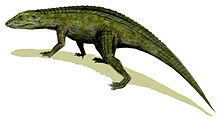
Live reconstruction of
Protosuchus richardsoni from the Early Jurassic of Arizona, USA
The Sphenosuchia belong to the first representatives of the Crocodylomorpha . They appeared in the Upper Triassic, around 230 million years ago, and lived until the late Jurassic. They were long-legged animals about three feet long, lived terrestrially and were facultatively biped, that is, they walked on two legs at least for a time. The Crocodyliformes split off from the early Crocodylomorpha. These can be seen as “crocodiles in the broader sense”. They contain exclusively four-legged (obligate quadrupede) representatives, with more or less crocodile-typical appearance. The Crocodylia or "crocodiles in the narrower sense" are that subgroup of the Crocodyliformes, which includes all recent crocodiles as well as their closest extinct relatives (crocodile crown group ).
One of the oldest known representatives of the Crocodyliformes was Protosuchus , who was distinguished by long legs and was probably a fairly quick hunter. A group of early crocodiles, the Protosuchia, was named after him . The closely related Orthosuchus looked similar . These animals were still adjusted to a way of life on the land, while almost all subsequent groups switched to an amphibious life in the water. A double-row of bone armor protected the back, and the stomach was also ossified. The Protosuchia were widespread until the early Jurassic on what was then the supercontinent of Pangea , in which all the mainland masses were united; today's finds come accordingly from East Asia , Europe , North and South America and South Africa .
The Mesoeucrocodylia
Shortly after the beginning of the Jurassic and the associated breakdown of the primary continent Pangea, another group of Crocodyliformes developed, which is now called Mesoeucrocodylia . This taxon replaces the previously common paraphyletic taxon Mesosuchia . As a monophyletic taxon, the Mesoeucrocodylia also contain the Eusuchia and thus represent a closed group ( taxon ) which, in addition to several other lines of development, also contains today's crocodiles (Crocodylia). The Thalattosuchia are among the first representatives of the Mesoeucrocodylia , they appeared in the early Jurassic about 190 million years ago and were found mainly in Europe. These oldest forms were evidently marine life as they were found in marine deposits. One of their families were the Teleosauridae . These animals are particularly characterized by their specialized, elongated jaws with long and pointed teeth that could be used for fishing. The front legs were shortened, but could also be used on land. Like the Protosuchia, they also had plate armor. Forms of up to 10 meters in length such as Machimosaurus developed among them . The later second family, the Metriorhynchidae from the Middle Jurassic, was even more adapted to the way of life in the sea . Their limbs developed into fins, and the tail became a strong caudal fin, which gave the animals even better propulsion. Due to the special adaptations, these species are referred to together with other marine crocodile taxa as marine crocodiles . They died out in the Early Cretaceous . The Thalattosuchia are alternatively placed as members of the Neosuchia in the vicinity of the Tethysuchia.
The Metasuchia

Skull of
Kaprosuchus saharicus (MNN IGU12), scale = 10 cm, from the late Cretaceous from northern
Niger
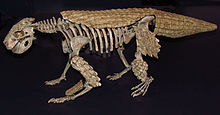
Reconstruction of the skeleton of
Simosuchus clarki from the late Cretaceous Northwest Madagascar
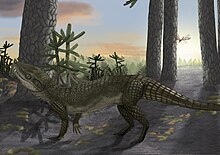
Live reconstruction of
Pakasuchus kapilimai from the Middle Chalk of Southwest Tanzania
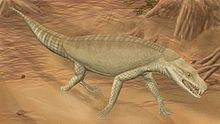
Live reconstruction of
Armadillosuchus arrudai from the late Cretaceous of southern Brazil
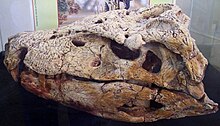
Skull of
Baurusuchus salgadoensis from the late Cretaceous of southern Brazil

Skull of
Sebecus icaeorhinus from the
Mid or Late Eocene of Patagonia, Argentina
Relationships of the Notosuchia (according to Pol and colleagues, 2014).
In the early Jurassic the Metasuchia appeared as a further group of the Mesoeucrocodylia. This taxon is not considered necessary by all paleontologists and is therefore sometimes seen as a synonym of the Mesoeucrocodylia. The point of view depends particularly on the assumed position of the Thalattosuchia. The large group of the Metasuchia split early into the Notosuchia and the Neosuchia . So far, however, there has been great disagreement as to the point at which the two groups were separated. The Notosuchia that appeared in the early Cretaceous include the members of the Uruguaysuchidae living on the southern continents, such as the small species of the genus Araripesuchus . They were widespread in South America and Africa. At the same time as the Uruguaysuchidae lived the larger Trematochampsidae , which were more amphibious and colonized the rivers. Their exact relational classification is still controversial. Possibly they are close to the Peirosauridae . Another line of Notosuchia are the Ziphosuchia from the late Cretaceous. It includes the Libycosuchidae from Africa and the land-living Notosuchidae from South America. Other Ziphosuchia are the land-living Sebecosuchia of the southern continents. At the beginning of the Tertiary , they lived as giant predators with teeth specially designed to cut meat, similar to the carnivorous dinosaur. The Sebecidae and the Baurusuchidae represented important groups . The Sebecidae also lived in Africa and Europe, but died out again in the Eocene , the earliest epoch of the Tertiary. In South America, however, they were the dominant predators until the end of the Tertiary. The reason was the isolation of the South American continent from the rest of the world at that time, so that carnivorous mammals were no competition for them.
The Neosuchia
Live reconstruction of Stomatosuchus inermis from the late Cretaceous Egypt
Skeleton of Bernissartia fagesii from the late Cretaceous Belgium
Reconstructed skull of Sarcosuchus imperator from the early Cretaceous north Niger , Africa
Live reconstruction of Elosuchus cherifiensis from the early Cretaceous North Africa
Skull of Teleorhinus or Terminonaris robusta from the late Cretaceous Montana, USA
Live reconstruction of Dyrosaurus phosphaticus from the Eocene of North Africa
Live reconstruction of Goniopholis simus from the early Cretaceous of Germany
Systematics
Relationships of the Neosuchia (based on de Andrade and colleagues, 2011).
The first Neosuchia lived in the early Jurassic. A little later, the rather small Atoposauridae of the Upper Jurassic and Lower Cretaceous appeared, which occurred exclusively in Laurasia, among them Theriosuchus pusillus from today's Great Britain . These animals, which live half in the water and half on the land, belong to a line of development that also includes the later modern crocodiles, the Eusuchia . The distinguishing feature are the vertebrae, which appeared here for the first time as procoelic vertebral bodies with an anterior indentation, while all previously existing species had amphicoele or biconcave vertebral bodies, i.e. vertebrae with an anterior and posterior indentation. More closely related to the Eusuchia were the Goniopholididae of the late Jurassic , which also belonged to the Neosuchia . According to fossil finds in North America, Europe and Thailand, these river and lake inhabitants lived exclusively on what was then the northern continent of Laurasia . They were large crocodiles with blunt snouts. The Stomatosuchidae split off from this line of development . Although the fossil record of the following period is relatively sparse, it can be assumed that the Neosuchia spread quite quickly. There was a find from the late Cretaceous in what is now Egypt that belongs to the group of the Stomatosuchidae. This species is known as Stomatosuchus and had an almost duckbill-like snout. The Eusuchia come from a line that split off shortly before. Another branch of Neosuchia are the Tethysuchia ; they include the schmalschnauzigen pholidosauridae , including from Africa originated Sarcosuchus imperator with a skull of two meters long and a total length of about 11 meters. In the late Cretaceous, particularly long- snouted species such as Terminonaris ( Teleorhinus ) developed, which in turn went into the sea. At the same time, other Tethysuchia lived on the coasts of the Tethys of Africa and South America, which had adapted to life and hunting in the sea. These Dyrosauridae , among them Dyrosaurus , were also long-snouted and so specialized in fishing. Like many of their relatives, they survived the mass extinction on the Cretaceous-Tertiary border, but probably died out by the end of the Eocene due to competition with marine gavials and early whales .
The Eusuchia - the "modern" crocodiles

Live reconstruction of
Isisfordia duncani from the Central Cretaceous Queensland, Australia

Live reconstruction of
Allodaposuchus precedens from the Late Cretaceous of Southern Europe

Artistic reconstruction of
Aegisuchus witmeri as a fish
hunter , from the late Cretaceous of Morocco

Fossil of
Borealosuchus wilsoni from the Early or Middle Eocene from Wyoming, USA
Relationships of the Eusuchia (after Buscalioni and colleagues, 2011).
Relationships of the Eusuchia (after de Andrade and colleagues, 2011).
Relationships of the Eusuchia (after Holliday & Gardner, 2012).
Relationships of the Eusuchia (after Bronzati, Montefeltro & Langer, 2012).
The first representatives of the Eusuchia appeared in the early Cretaceous period . In the late Cretaceous these were already the dominant group of crocodiles. There is still disagreement about the point from when one can speak of Eusuchia and when one can still speak of Neosuchia. The most important group of the Eusuchia are the Crocodylia. Here, too, the delimitation of the Crocodylia from the rest of the Eusuchia has not yet been fully clarified. The Aegyptosuchidae are very close relatives of the Crocodylia . Aegisuchus from what is now Morocco is one of their representatives.
The Crocodylia - the "real" crocodiles
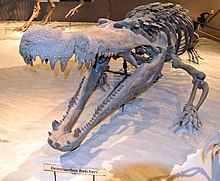
Skeleton reconstruction of
Deinosuchus hatcheri or
Deinosuchus rugosus in the Natural History Museum of Utah, from the late Cretaceous from the eastern USA

Cast of a fossil of the double dog-tooth crocodile (
Diplocynodon darwini , young animal) from the Middle
Eocene of the
Messel Pit , Germany
Relationships of the Crocodylia (after Martin, 2007; Martin, 2010; Martin & Gross, 2011).
Relationships of the Crocodylia (after Brochu, 2001; Brochu, 2003; Vélez-Juarbe, Brochu & Santos, 2007; Brochu and colleagues, 2010; Brochu, 2011; Brochu and colleagues, 2012; Brochu & Storrs, 2012).
Representatives of the real crocodiles (Crocodylia) already existed 80 million years ago .
Deinosuchus from North America was one of the early representatives of the Alligatoroidea , a taxon that includes the closer relatives of the Alligatoridae; Representatives of the Crocodyloidea , a taxon that includes the closer relatives of the Crocodylidae, also occurred during this period, especially in what is now North America. The direct ancestral line of these two taxa, which then also leads to the real crocodiles (Crocodylidae) and the alligators (Alligatoridae), is still somewhat in the dark, Mekosuchus inexpectatus , a representative of the Mekosuchinae , is the only fossil species that shows features of both groups . It was a rural species that lived in New Caledonia until the historical period around 3500 to 3900 years ago. The land crocodile Quinkana fortirostrum also belonged to the Mekosuchinae . For almost the entire Tertiary, both Crocodyloidea and Alligatoroidea were widespread across all northern continents. The Crocodyloidea and the Alligatoroidea are sometimes grouped together as Brevirostres . There were representatives of these two groups in Europe too. A well-known form of the alligatoroid from Europe is Diplocynodon , a representative of the Diplocynodontinae . Also in Europe lived the Pristichampsidae , a group of crocodiles with hoof-like toes.
Representatives of the Crocodylinae , to which the current genera and species of crocodiles also belong, appeared for the first time since the early Tertiary (Eocene or Oligocene ). So one found fossils of the Nile crocodile ( Crocodylus niloticus ) and the West African slender-snouted crocodile ( Mecistops cataphractus ) at the end of the Tertiary and Pleistocene , with Rimasuchus lloidi but an even earlier representatives of the African Crocodylinae was found. Crocodylus palaeindicus is also known from Asia . Little is known about the origin of the other species of the genus in the oceanic islands and South America, as well as the first appearance of the stump crocodile ( Osteolaemus tetraspis ) and the Sunda gavial ( Tomistoma schlegelii ).
The evolution of today's alligators and caimans ( Alligatoridae ) is also only poorly documented. Alligator olseni from the Miocene is considered to be the ancestor of the Mississippi alligator ( Alligator mississippiensis ) . The first records of the Chinese alligator ( Alligator sinensis ) come from the Pleistocene. An early representative of the caimans ( Caimaninae ) was Eocaiman cavernensis . Purussaurus neivensis lived in the Miocene .
The origin of the Gaviale ( Gavialidae ) is largely unclear . According to some researchers, these may even represent an early branch of the Mesoeucrocodylia, which has survived to this day with the gharial. More widespread, however, is the view that they are a sister group of the other two modern crocodile taxa, which descend from long-snouted forms of the coastal waters of North Africa. From there, the early gavials spread to Europe, Asia and America and experienced radiation in South America before they became extinct worldwide for reasons that have not yet been clarified, apart from the only species still alive today in India. Probably due to the worsening climate and cooling at the end of the Tertiary, many other groups of species also disappeared from the northern ranges in North America, Asia and Europe.
Web links
Individual evidence
-
↑ see e.g. B .: Kerstin Schmidt-Denter: Jumping off death by the shovel - some “living fossils” were lucky. scinexx.de, April 12, 2001.
-
↑ Phil Senter: Phylogenetic taxonomy and the names of the major archosaurian (Reptilia) clades. In: PaleoBios. Volume 25, No. 3, 2005, pp. 1-7 ( abstract ).
-
↑ Sterling J. Nesbitt, Stephen L. Brusatte, Julia B. Desojo, Alexandre Liparini, Marco AG De França, Jonathan C. Weinbaum, David J. Gower: Rauisuchia. In: Sterling J. Nesbitt, Julia B. Desojo, Randall B. Irmis (Eds.): Anatomy, Phylogeny and Palaeobiology of Early Archosaurs and their Kin. (= Geological Society, London, Special Publications. Volume 379). Geological Society of London, London 2013, pp. 241-274, doi: 10.1144 / SP379.1 .
-
↑ Michael J. Benton: Paleontology of the vertebrates. 3rd edition (translation of the 3rd English-language edition by Hans-Ulrich Pfretzschner), Verlag Dr. Friedrich Pfeil, Munich 2007, ISBN 3-89937-072-4 , p. 139.
-
↑ Stephen L. Brusatte, Michael J. Benton, Julia B. Desojo, Max C. Langer: The higher-level phylogeny of Archosauria (Tetrapoda: Diapsida). In: Journal of Systematic Palaeontology. Volume 8, No. 1, pp. 3-47, doi: 10.1080 / 14772010903537732 .
-
↑ D. Pol, PM Nascimento, AB Carvalho, C. Riccomini, RA Pires-Domingues, H. Zaher: A New Notosuchian from the Late Cretaceous of Brazil and the Phylogeny of Advanced Notosuchians . In: PLoS ONE . 9, No. 4, 2014, p. E93105. doi : 10.1371 / journal.pone.0093105 . PMID 24695105 .
-
^ A b Marco Brandalise de Andrade, Richard Edmonds, Michael J. Benton, Remmert Schouten: A new Berriasian species of Goniopholis (Mesoeucrocodylia, Neosuchia) from England, and a review of the genus . In: Zoological Journal of the Linnean Society . 163, No. s1, 2011, pp. S66-S108. doi : 10.1111 / j.1096-3642.2011.00709.x .
-
↑ AD Buscalioni, P. Piras, R. Vullo, M. Signore, C. Barbera: Early eusuchia Crocodylomorpha from the vertebrate-rich Plattenkalk of Pietraroia (Lower Albian, southern Apennines, Italy) . (PDF) In: Zoological Journal of the Linnean Society . 163, 2011, pp. S199-S227. doi : 10.1111 / j.1096-3642.2011.00718.x .
-
↑ Casey M. Holliday, Nicholas M. Gardner: A New Eusuchian Crocodyliform with Novel Cranial Integument and Its Significance for the Origin and Evolution of Crocodylia . In: PLoS ONE . 7, No. 1, 2012, p. E30471. doi : 10.1371 / journal.pone.0030471 . PMID 22303441 . PMC 3269432 (free full text).
-
↑ M. Bronzati, FC Montefeltro, MC Langer: A species-level Supertree of Crocodyliformes . In: Historical Biology . 2012, p. 1. doi : 10.1080 / 08912963.2012.662680 .
-
^ JE Martin: New material of the Late Cretaceous globidontan Acynodon iberoccitanus (Crocodylia) from Southern France . In: Journal of Vertebrate Paleontology . 27, No. 2, 2007, pp. 362-372. doi : 10.1671 / 0272-4634 (2007) 27 [362: NMOTLC] 2.0.CO; 2 .
-
^ JE Martin: A new species of Diplocynodon (Crocodylia, Alligatoroidea) from the Late Eocene of the Massif Central, France, and the evolution of the genus in the climatic context of the Late Palaeogene . In: Geological Magazine . 147, 2010, pp. 596-610. doi : 10.1017 / S0016756809990161 .
-
^ JE Martin, M. Gross: Taxonomic clarification of Diplocynodon Pomel, 1847 (Crocodilia) from the Miocene of Styria, Austria . In: New Yearbook of Geology and Paleontology - Treatises . 261, No. 2, 2011, pp. 177-193. doi : 10.1127 / 0077-7749 / 2011/0159 .
-
↑ CA Brochu: Crocodylian snouts in space and time: phylogenetic approaches toward adaptive radiation . In: American Zoologist . 41, No. 3, 2001, pp. 564-585. doi : 10.1668 / 0003-1569 (2001) 041 [0564: CSISAT] 2.0.CO; 2 .
-
^ CA Brochu: Phylogenetic approaches toward crocodylian history . In: Annual Review of Earth and Planetary Sciences . 31, 2003, pp. 357-97. doi : 10.1146 / annurev.earth.31.100901.141308 .
-
↑ J. Velez-Juarbe, CA Brochu, H. Santos: A gharial from the Oligocene of Puerto Rico: transoceanic dispersal in the history of a non-marine reptile . In: Proceedings of the Royal Society B . 274, No. 1615, 2007, pp. 1245-1254. doi : 10.1098 / rspb.2006.0455 . PMID 17341454 . PMC 2176176 (free full text).
-
↑ CA Brochu, J. Njau, RJ Blumenschine, LD Densmore: A New Horned Crocodile from the Plio-Pleistocene Hominid Sites at Olduvai Gorge, Tanzania . In: PLoS ONE . 5, No. 2, 2010, p. E9333. doi : 10.1371 / journal.pone.0009333 . PMID 20195356 . PMC 2827537 (free full text).
-
^ CA Brochu: Phylogenetic relationships of Necrosuchus ionensis Simpson, 1937 and the early history of caimanines . In: Zoological Journal of the Linnean Society . 163, 2011, pp. S228-S256. doi : 10.1111 / j.1096-3642.2011.00716.x .
-
↑ Christopher A. Brochu, David C. Parris, Barbara Smith Grandstaff, Robert K. Denton, William B. Gallagher: A new species of Borealosuchus (Crocodyliformes, Eusuchia) from the Late Cretaceous-early Paleogens of New Jersey . tape 32 , no. 1 , 2012, ISSN 0272-4634 , p. 105–116 , doi : 10.1080 / 02724634.2012.633585 .
-
↑ CA Brochu, GW Storrs: A giant crocodile from the Plio-Pleistocene of Kenya, the phylogenetic relationships of Neogene African crocodylines, and the antiquity of Crocodylus in Africa . In: Journal of Vertebrate Paleontology . 32, No. 3, 2012, pp. 587-602. doi : 10.1080 / 02724634.2012.652324 .
























